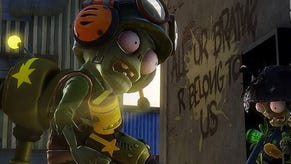Face-Off: Plants vs Zombies: Garden Warfare
Xbox 360 takes on Xbox One. Digital Foundry assesses the generational divide.
Despite the ridiculous premise, PopCap has managed to successfully translate an addictive casual strategy game into an expertly crafted tower defence third-person shooter that offers up a refreshing alternative to the likes of Battlefield 4 and Call of Duty. Displaying a careful balancing act between large open environments and more confined locations with a range of vantage points, PopCap utilises the Frostbite 3 engine to deliver large colourful maps backed up with some solid visual effects made possible by DICE's state-of-the-art rendering tech, including limited destructible scenery. The game also works well as an online experience, pulling players together as a team, and the net code appears solid - PopCap doesn't seem to be facing the wealth of issues that spoiled DICE's otherwise excellent Battlefield 4.
While the PC version isn't due out until some time in the Spring (with PS3/PS4 releases believed to hit further down the line), the 360 and Xbox One releases are available now, and showcase a distinct balancing act between frame-rate and graphical complexity that will appear familiar to those following previous cross-generation titles. On the Xbox 360 Garden Warfare goes for a common 30fps refresh, while aiming for a modest 720p resolution, whereas on Xbox One the stakes are set much higher, with silky smooth gameplay at a target 60fps and a much higher resolution than its last-gen counterpart.
So how well does Plants vs Zombies: Garden Warfare hold up on the older Microsoft console? And just how close do the developers come to bringing us the definitive 60fps experience at 1080p on the Xbox One?
From a basic framebuffer standpoint, we're in familiar territory with the 360 version of Garden Warfare. The game adopts the 1280x704 resolution as seen in Battlefield 4, which sees eight lines of pixels getting cropped at the top and bottom of the screen. This results in the appearance of small black borders above and below the main image, but these are small enough to 'disappear' during gameplay as they cover such a small portion of the screen. Meanwhile, anti-aliasing is provided by a post-process solution that doesn't overtly blur texture details, though coverage is quite light and this does lead to some noticeable pixel shimmer around distant and more complex scenery.
On the Xbox One side of things, the 1080p dream isn't quite realised, with the developers opting for a 1600x900 framebuffer instead. The impact to artwork quality seems to be fairly mild, although fine texture details appear slightly softer than a full 1080p resolution. In any case, the image benefits from a considerable sharpness boost over the 360, while the use of a stronger post-process AA solution helps to reduce edge artefacts created during the upscaling process to 1080p, giving the game a reasonably smooth look as a result. In terms of a direct comparison between the two versions, here's a comparison gallery to mull over, along with a head-to-head video.
"On a base level, the core gameplay elements are the same between Xbox 360 and Xbox One, but the experience is transformed for the better on the next-gen platform."
In terms of the core graphical make up of the game, it's clear that Garden Warfare shares many of the same features across both of Microsoft's consoles: effects such as SSAO successfully add depth to the environments, and dynamic cloud coverage affects how outdoor areas are illuminated, leading to differences in where shadows are cast in each version, and indeed, from scene to scene. Depth of field is also present, but used sparingly to gently soften objects that appear close to the horizon, rather than to aid in focusing your reticule when aiming.
Curiously, motion blur doesn't seem to have made the cut at all, in either camera or object-based varieties, perhaps indicating that PopCap's cute and colourful offering is actually running on a much tighter rendering budget than one might expect. Instead, hectic fire-fights are enhanced with liberal use of particle trails, while explosions are accompanied by a suitably impactful post-process screen distortion effect that warps the players view of the environment in some pretty cool "shaky cam" moments. Impressively, particle and alpha buffer are rendered in full resolution on both consoles, although on occasion we notice that some of the art assets for fire on 360 appear to be of a lower resolution than the other effects. The amount of transparent layers used for some weapon fire effects is also reduced slightly on the console, although the level of smoke and particles elsewhere is very similar.
These differences are minimal however, with the main cutbacks centring around the use of lower resolution textures on the 360, and more aggressive level of detail (LOD) streaming, leading to more noticeable pop in of higher quality assets and light sources during gameplay and at the beginning of each round. The lighting model is also simplified slightly, with the 360 game featuring fewer light sources used to illuminate the environment than on the Xbox One. Most notable is the absence of light shafts on the last-gen platform, which helps to add an extra glow to the environments on the Xbox One. The only other difference worth noting is that the Xbox One game features faked particle lighting via the use of what looks like a glow card (a bloom effect added to a light source, but not an actual dynamic light as such) applied to projectiles. However this effect has no impact on how surrounding objects are illuminated.

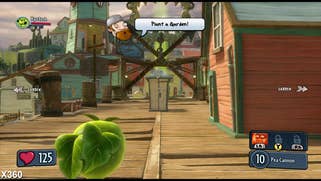

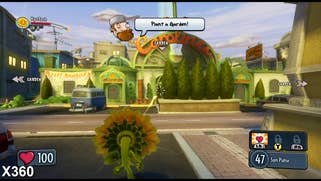


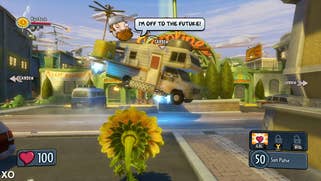
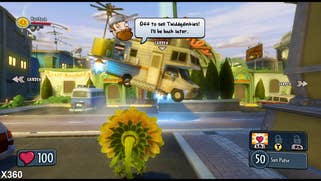

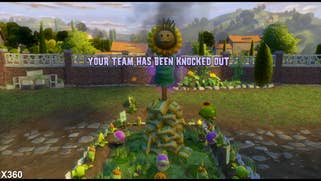
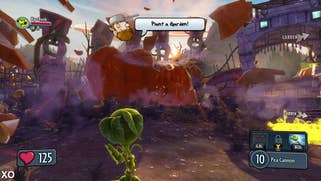

Moving onto performance, and due to the tower defence style gameplay in Garden Warfare, players tend to congregate together at specific points on each map, resulting in a war zone filled with a range of dynamic smoke, particles, and lighting effects. This makes for some really entertaining scenes when players are catapulted through the air by massive explosions, or are surrounded by a flurry of projectiles - but it also puts the engine under considerable stress.
Kicking off with a look at the 360 game, it's clear that PopCap has opted to retain the same basic performance profile as Battlefield 4. Garden Warfare targets a 30fps update and operates using adaptive v-sync. Each frame has 33ms to render, but if the GPU takes longer to complete this task, the framebuffer is flipped during the screen refresh, resulting in screen-tear. It's a familiar set-up that we've seen many times before, and allows for frames to be delivered to the screen as quickly as possible, thus reducing latency over that of a solidly v-synced set-up.
Indeed, in Garden Warfare the technique does help to keep frame-rates reasonably close to the desired 30fps target - even under heavy load - but the compromise is that the game tears continuously in demanding scenes, resulting in noticeable judder on screen and some additional input lag on the controls. Frame-rates are also impacted too when the action really heats up, further exacerbating the judder encountered when torn frames are repeatedly displayed on screen. Long draw distances and alpha-filled shootouts are the root causes for the sizeable drops in fluidity, as the engine struggles with the rendering load.
"Garden Warfare ticks the boxes on Xbox 360, but there's only so far that the veteran Microsoft console can take the game."
While the frequent variances in performance lead to the experience feeling decidedly uneven, arguably PopCap has made the right decision here in terms of prioritising controller response, even if the results can be unsightly at times. Thankfully, during smaller skirmishes in more confined spaces these problems are much less of an issue and we can enjoy the imaginative nature of the gameplay on a far more satisfying level. In these situations the engine hits its stride and manages to achieve something close to a locked 30fps for extended periods, as long as heavy smoke and particles don't enter the fray.
Moving onto the Xbox One, and Plants vs Zombies remains v-synced at all times on the platform, so we don't see any tearing whatsoever. The unsightly judder that regularly plagues the 360 release when the engine is under stress is also dramatically reduced, only appearing when there are frequent fluctuations in frame-rate, but to a much lesser extent. The improvement here compared to the 360 is night and day, with the 60fps target provided by the Xbox One not only delivering a far more consistent overall experience, but a tangible increase in the responsiveness of the controls - aiming and moving around simply feels lighter and more precise.
Microsoft's new machine also manages to hold a solid 60fps fairly frequently too: while there are a quite a few smaller drops in frame-rate these can often go by unnoticed during less heated exchanges, or when the action is spread out across the environment. Essentially drops of 5-10 frames have far less of an impact when running at 60fps than they do at 30, and this limits their impact on screen. Performance isn't quite so solid when the console is faced with larger scale confrontations, though, where more sustained drops in the 45-50fps area cause more noticeable variances in smoothness, but this rarely becomes an issue during a general run of play.
"The 60fps update makes a huge difference to the quality of the gameplay, but even with a 1600x900 resolution, Garden Warfare can't sustain a completely consistent, locked frame-rate."
Plants vs Zombies: Garden Warfare - the Digital Foundry verdict
With Plants vs Zombies: Garden Warfare, PopCap reaffirms that cute and colourful action games can be just as enjoyable and intense as some of the more adult orientated shooters - is a welcome sight to see in today's climate of predictably monotone brown and grey triple-A blockbusters. DICE's technologically advanced Frostbite 3 engine also helps to sell the overall experience through the inclusion of realistically illuminated environments, and liberal use of particle effects and projectiles that really spruce up the off-the-wall action. Most of the core graphical aspects are impressively carried over to both consoles too, showing that Frostbite 3 can still hand in some visually excellent results on the ageing 360 platform, while still providing Xbox One owners with a tangible upgrade that can be felt from both a graphical and gameplay perspective.
Given the massive leap in memory and processing power, Xbox One understandably delivers a sharper and more detailed experience overall, suffering from fewer streaming issues and texture oddities. While the game fails to hit the magic 1080p, in this case it really isn't so much of a big deal, given how the style of the artwork and use of post-process AA helps to create reasonably smooth looking images. Ultimately, it's the higher frame-rate that really makes the Xbox One version of Plants vs Zombies stand out, allowing for smoother and more responsive gameplay that can only be achieved on console by running at 60fps.
In comparison, the experience is shakier on Xbox 360, and falls short in the kind of consistency and smoothness expected from an online shooter. However, on a more positive note, the 360 release still manages to remain very playable despite the frequent tearing problems, and the same exemplary gameplay is present across both consoles. This makes Garden Warfare well worth checking out on either platform, but clearly the experience is leagues ahead on Xbox One..






